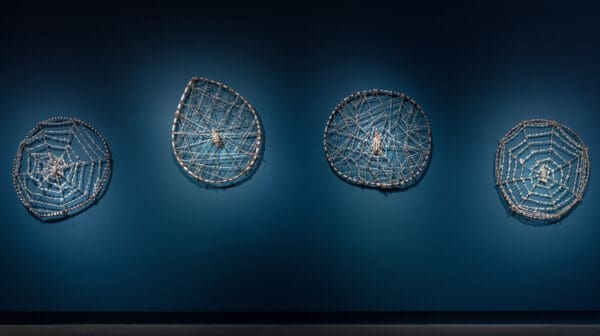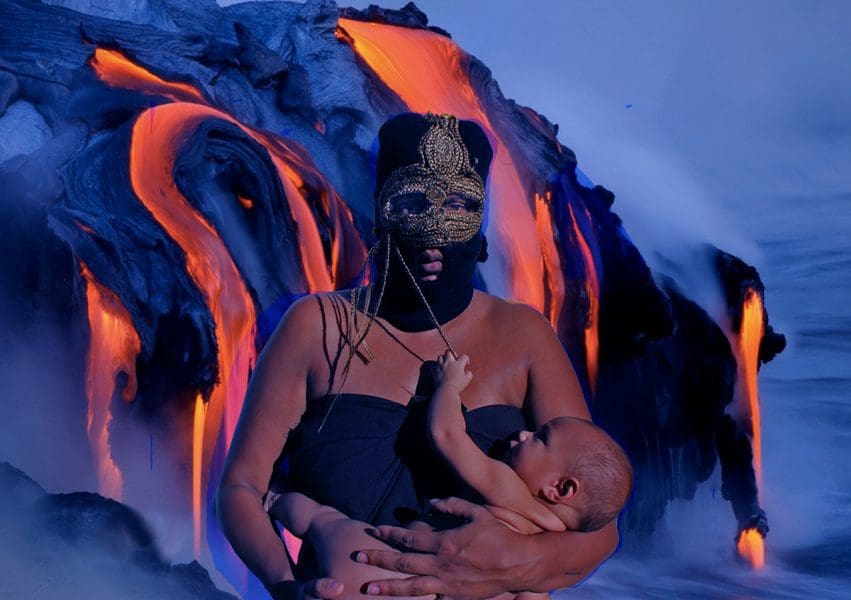
Piercing the veil
A new exhibition at Buxton Contemporary finds a rich complexity in the shadowy terrain between life and death.
The roles of Indigenous women in Australian communities are diverse: sharing knowledge, nurturing families and exhibiting boldly in the national art arena. Next Matriarch is part of Adelaide’s Tarnanthi Indigenous art festival. Curated by Kimberly Moulton and Liz Nowell, this group exhibition brings together Aboriginal artists Paola Balla, Ali Gumillya Baker, Hannah Brontë, Miriam Charlie, Amrita Hepi, Nicole Monks, and Kaylene Whiskey to reflect on the changing face of matriarchy in contemporary Australia.
To Yamatji Wajarri, Dutch and English artist Nicole Monks, female community is not only a personal network but a heartening, intangible bond to all of womankind. Her video work Mother is a hypnotic non-verbal expression of how the common capacity and experience of pregnancy charges women with strength and kinship. Uninhibited and revelling in the beauty of female self-knowledge, the video came about completely spontaneously, during a generic photo shoot. “I was smiling and hugging my belly, like everybody does, but it just wasn’t what I was feeling,” Monks explains. “I was freaking out. There was a whole person growing inside me and I kept asking myself, how am
I going to get it out?”
Monks performed instinctive movements, successive photographs reveal a crescendo of gestures and a shift from feeling alone to “completely connected to all women from all time. I felt my place in that connected chain, from the past into the future.” In Mother, Monks has turned these photos into a video work with a shadowy background and rhythmic score in and out of which the image of her pregnant body emerges, symbolically embracing the legendary capacity of the female body. “In my movements, with my hands, I was imagining the birth. In that moment I felt that it was possible, that I was going to be able to do it. I was not afraid, but empowered.”

Almost two years on, baby Yarra accompanies Monks while she talks art and recounts the whole-body transformations of those 40 or so exceptional weeks. “I was responding to an emotional state, manifesting
it physically, to understand and communicate these emotions better.” Monks knows the isolating pressure on new mothers, the excess of information, conflicting advice, expensive products and endless decisions. “As a strong Aboriginal woman, I want to empower women to trust their intuition, innate knowledge, community and ancestors.”
Throughout her practice, Paola Balla honours her matriarchal ancestry, the Wemba-Wemba women who’ve guided and supported generations of her family. Hers is no hobby-ish genealogy. She incorporates all Aboriginal women who have braved colonisation, dispossession, child removal and abuse, emerging as the leaders and protectors of their descendants.
When I see it I feel comforted and connected,” she says. Printed onto wallpaper, the landscape is accompanied by photographs of six generations of women, from Balla’s great-great-grandmother to her kids. “It wasn’t normal for Aboriginal families to have cameras,” she says, “Our historic photographs are so precious.” In this vision, Aboriginal women are contiguous with the land itself; their courage drawn from it and their compassion consolidated back into it. As her elders age, this work takes on real urgency. “I don’t want these women forgotten. Coming generations should know their struggle and their strength.” A blank space anticipates a seventh generation, who Balla hopes will escape the aftershock of colonial trauma through the healing of previous generations.
Balla’s practice hinges on intimate exchange with the women around her. She practices “deep listening and reciprocity” during interviews, offers food and fair payment to her collaborators, and observes women’s gatherings. This approach echoes that of professor Tracey Bunda, Balla’s mentor. Bunda recently had open-heart surgery and commissioned Balla to photograph her surgical scar: a portrait to caution Aboriginal women to mind their health. At the time Balla was recovering from acute trauma and had all but given art making away. “She spoke gently, made tea. We sat in the sunlight. By trusting me when I didn’t trust in myself, she helped me heal.”
“You’ve got to be rock hard to hold that space for other people. For me, the future is safer if it’s Indigenous and female, but not in a narrow sense: when matriarchs lead, people are happier, healthier and safer.” So, Balla honours these “proud, beautiful and articulate” matriarchs, the aunties who send emu feathers from country; her mother and grandmother, stylish curators of beautiful objects; the sisters and cousins who simply “get together, laugh, tease and tell stories.”
A matriarch, according to co-curator Kimberley Moulton, is a woman with “wisdom and strength. They support others, particularly the women in their lives.” Accordingly, this new wave of female, Aboriginal voices is proud and intrepid, plunging headlong into difficult histories, contemporary media and celebration of each other.
Next Matriarch
Ace Open, Adelaide
14 October – 9 November